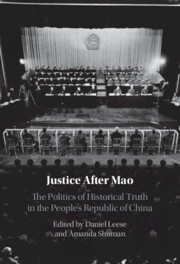Introduction
Published online by Cambridge University Press: 31 August 2023
Summary
The Introduction broadly contextualizes how the CCP dealt with historical injustices after Mao Zedong’s death. It provides the necessary framework for understanding the processes and practices that are further explored and examined in the following sections and chapters of the book while shedding light on how selectively applied approaches today associated with the concept of transitional justice may serve to strengthen rather than subvert authoritarian rule. It also highlights the most outstanding features of the CCP’s politics of historical justice before placing these strategies against the backdrop of recent debates on crucial paradigms of transitional justice. Specifically, it introduces two key channels (“property” and “the mechanics of rehabilitation”) through which the government and public sought to concretely redress Mao-era historical injustices and efforts to construct meaningful “truths” of these injustices (“the politics of truth” and “memory”)
- Type
- Chapter
- Information
- Justice After MaoThe Politics of Historical Truth in the People's Republic of China, pp. 1 - 20Publisher: Cambridge University PressPrint publication year: 2023



